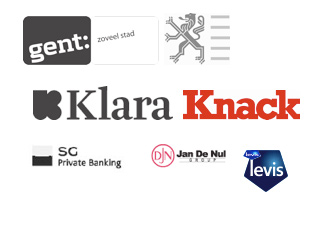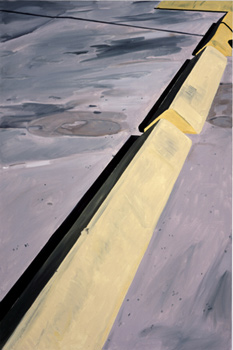Loek Grootjans:
Leaving Traces
and
Koen van den Broek:
Curbs & Cracks
January 30 – May 16, 2010
Citadelpark – 9000
Ghent – Belgium
T +32 (0)9 240 76 01
F +32 (0)9 221 71 09
museum.smak [at] gent.be
Loek Grootjans
30.01.2010…16.05.2010
For the Leaving Traces exhibition, S.M.A.K. has selected three key works by the Dutch artist Loek Grootjans (b.1955). There is one thing we can say about Grootjans with absolute certainty: he thinks in terms of systems and takes his artistic practice very seriously, in the sense that everything is thought out down to the very last detail. When talking about Grootjans’ work, we have to refer to the specific framework he has created for it. This was in 1998 when he established the Foundation for the benefit of the aspiration and the understanding of context (formerly known as the institute for immediate knowledge, real perception and logic features according to the most contemporary monochrome paintings). This foundation has various departments, sub-departments and divisions that have increasingly subdivided over the years. The whole system functions like a gigantic construction around something that is actually physically absent from Grootjans’ oeuvre, and which precisely because of this defines and pervades even more forcefully everything he embarks on and creates.
In 2008, in collaboration with the museum, Grootjans launched a publication entitled Foundation, which systematically examines all the departments he had set up since 1998. Now, two years later, this collaboration has been extended in the form of the Leaving Traces exhibition. It focuses on three works of art from Foundation. These works each play a key role in Grootjans’ oeuvre. By bringing them together we are given an insight into his artistic practice which, since he started his career at the end of the 80s, has seen a great many developments.
He began his career at the end of the eighties producing purely monochrome paintings. These were inspired by an experiment he did in 1988. He shut himself up in a room without light for a month. He also wore a blindfold to make sure he could see absolutely nothing. Gradually brown patches began to appear in the completely empty darkness. When he finally left the room and removed the blindfold he was overwhelmed by a bright green colour. This colour experience was so powerful that from then on he used only browns and greens as the basis for his paintings. Aware of his position as a monochrome, abstract painter, especially with regard to his great predecessors Mondriaan, Malevich, Newman, Reinhardt, Klein and so on, he approached his work very seriously and without compromise, starting with the amount of paint to be used, which is something he has always determined very precisely before starting to paint. Every stray drop or blob of paint was carefully recycled. This system implies a ‘delayed stop’ in the act of painting: once all the paint had been used up, the artist was forced to stop painting. In 1998 Loek Grootjans cleared out his studio and collected every remnant of paint, including every little drop that had fallen on the floor. He collected all these ‘last’ remnants of paint – the DNA of all the years of his artistic practice and system – in a Petri dish and called it The Final Remains of a contemporary monochrome Painter… which is also the first work of his to be exhibited at the S.M.A.K.
The Remembering Department is shown in conjunction with this work. We see a storage room with shelving against a wall. The shelves are empty and covered with a thick layer of dust, except for a space here and there which has been kept dust-free. Arranged on these spaces are the objects Grootjans has used in various Foundation projects since he set it up. The dust comes from the artist’s studio and he has carefully amassed it over the years.
The third key work is The Good Care Department. During a visit to the Opera Paese in Rome in 2001, Grootjans encountered election posters near the arts centre, featuring the surgically enhanced head of the television magnate Silvio Berlusconi and with the slogan: ‘Who takes good care of himself, takes good care of those who choose him.’ Inspired by this, Grootjans created a mural in which he juxtaposed the slogan diagrammatically with extracts from his book Visioen van de overkant (2002). The writing comprises many ‘observations’ and each one shows a subset of what concerns man in his happiness, fear, horror, desires, pleasures and obscenities. It shows an endless series of profundities, foolishness, delights and shamelessness linked together. In other words, Visioen van de overkant contains every possible definition of ‘the other’. Several versions of the Opera Paese mural have been shown in various contexts and in a number of different languages. At the S.M.A.K. Grootjans puts together another version of The Good Care Department.
Leaving Traces turns the spotlight on three major installations by Loek Grootjans. Each marks a new direction the artist has taken in his work and together they give us a picture of his artistic practice. After the exhibition the museum will select one of the works for its permanent collection.
Catalogue
Titel: Foundation for the benefit of the aspiration and the understanding of context (formerly known as the institute for immediate knowledge, real perception and logic features according to the most contemporary monochrome paintings)
Publication date: 2008
Publisher: Museum Bommel van Dam, S.M.A.K., Opera P-Pers Publishers
For sale in the museum
Curbs & Cracks
Koen van den Broek
30.01.2010…16.05.2010
In January 2010 S.M.A.K. will be opening its doors for Curbs & Cracks, a retrospective exhibition of work by the Belgian artist Koen van den Broek (b. 1973, Bree). It will focus on a young artist who, within the space of a very short time – 10 years – has consistently and confidently developed a body of work that is known and appreciated all over the world. The exhibition in the S.M.A.K. – compiled by Andrew Renton (Goldsmiths College, London) and Thibaut Verhoeven (S.M.A.K. Ghent) – brings together both new and existing work from the period 1999-2009, which is found in private and public collections all over the world.
Koen van den Broek finds his inspiration in being ‘en route’ and his work is nurtured by dozens of road trips. Using his own snapshots the artist creates the basis for his paintings, and in a manner that is to the point and functional. Unlike a sketchbook, the photographic images serve only as a reminder and record interesting lines, structures and twists in the landscape he has observed. They are only formal recollections of what he has perceived and have little or no emotional value. The recordings appear to ‘reject being en route. What interest the artist are the small segments of reality which most of us seem not to really notice. A kerb, a collection of shadows on the road suggesting the presence of a truck, a barren, snow-covered forest landscape, a simple house with a special emphasis on the trivial garage door, a motorway with an interesting yet stereotype curve in the landscape and cracks in the asphalt which nobody notices. He sees the rear- or side views of objects, houses, and urban or natural landscapes. He focuses on his subject in such a way that it becomes trivial. What could be an impressive viaduct in a landscape becomes a dark, functional construction with a fragment of its natural context on the left and on the right. This ‘antisocial’ focus is linked to a painterly process in which van den Broek strips the images of all unnecessary detail so that the atmosphere is defined only by several basic lines… thus leaving us with the ‘experience’ of space. The painterly execution flirts with abstraction. The choice of title negates this however, by taking the image back to reality. The unusual colours – ranging from cold white to every imaginable tone of grey combined with a carefully chosen blue, red, yellow or orange – confuses the spectator. Koen van den Broek is not at all interested in painting ‘realistic scenes’ but fervently seeks atmospheric ‘possibilities’. What he presents to the spectator are paintings, not landscapes, kerbs or buildings.
Curbs & Cracks shows a selection of existing work linked to a series of new paintings. He also brings in a large wall painting. The whole is developed around several sensitive issues and motifs, which are consistently, yet intermittently present in Koen van den Broek’s work. He creates ‘consistent’ spaces which balance between the conceptual contours of the painting and photographic depictions of reality. The exhibition is developed around delineated clusters of works, choices that are substantiated purely formally and thematically as well as regarding content. Here we are struck by the repetition that is associated with these – both regarding the abovementioned and in the meantime recognisable – motifs, as well as the underlying method. This invites the spectator to look for inconsistencies. Indeed, the use of photography as a neutral link between reality and painterly creation does not always appear to be ‘necessary’. Recent creations react to existing work, act within the body of work as a catalyst that nurtures and strengthens the whole, or precisely in contrast to this, acts as a virus that infects and weakens all the carefully developed patterns.
Curated by Andrew Renton & Thibaut Verhoeven
Courtesy White Cube Londen / Figge von Rosen Galerie Keulen / Greta Meert Gallery Brussels
Catalogue
On a parallel with the exhibition Valis publishers in Amsterdam will publish a catalogue. The book entitled ‘Crack’ cannot be regarded as a ‘classic’ catalogue but is an independent, discursive and visual project that accompanies the exhibition. On a parallel with the exhibition the book may be regarded as the first substantial study of Koen van den Broek’s work as a whole.
In this book Koen van den Broek’s work placed in a framework of various approaches: the legacy of abstract painting (Andrew Renton, Goldsmiths University, London), the collaboration with John Baldessari (John Welchman, University of California, San Diego), film as a source of inspiration (Merel van Tilburg, Université de Génève), the role and meaning of photography (Dirk Lauwaert, Brussels), exhibition strategies (Liesbeth Bik en Jos van der Pol, Rotterdam) and the representation of landscape and architecture (Wouter Davidts, VU University Amsterdam).
The book is compiled by Wouter Davidts and designed by Metahaven.
Figures & Facts:
Title: Crack – Koen van den Broek
Editor: Wouter Davidts
Publisher: Valiz, Amsterdam
Lay-out: Metahaven
Date: January 2010
Images.
Images of the exhibited works can be found on www.smak.be under the heading ‘info’ and then ‘press’. To download these images you need a login and password. Requests for these may be made to Els Wuyts: els.wuyts@gent.be, +32 (0)9 240 76 47.
Contact.
Els Wuyts
Press & Communication S.M.A.K.
Citadelpark
9000 Ghent
T +32 (0)9 240 76 47
M +32 (0)495 89 05 26
E els.wuyts@gent.be
W www.smak.be



